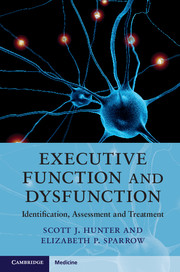Book contents
- Frontmatter
- Contents
- Editor biographies
- List of Contributors
- Preface
- Acknowledgments
- Introduction
- Section I Foundations of Executive Function/Dysfunction
- Chapter 1 Models of executive functioning
- Chapter 2 The developmental neuropsychology of executive functions
- Chapter 3 The neurobiology of executive functions
- Chapter 4 Assessment and identification of executive dysfunction
- Section II Executive Dysfunction in the Neurodevelopmental and Acquired Disorders
- Section III Applications
- Appendix 1 Abbreviations used in the book
- Appendix 2 Tests/tasks referenced in the book
- Index
- References
Chapter 3 - The neurobiology of executive functions
from Section I - Foundations of Executive Function/Dysfunction
Published online by Cambridge University Press: 05 October 2012
- Frontmatter
- Contents
- Editor biographies
- List of Contributors
- Preface
- Acknowledgments
- Introduction
- Section I Foundations of Executive Function/Dysfunction
- Chapter 1 Models of executive functioning
- Chapter 2 The developmental neuropsychology of executive functions
- Chapter 3 The neurobiology of executive functions
- Chapter 4 Assessment and identification of executive dysfunction
- Section II Executive Dysfunction in the Neurodevelopmental and Acquired Disorders
- Section III Applications
- Appendix 1 Abbreviations used in the book
- Appendix 2 Tests/tasks referenced in the book
- Index
- References
Summary
Executive functions are a set of interdependent, progressively acquired, higher-order cognitive skills that emerge in tandem with the expansion and integration of cerebellar, subcortical, corticocortical, and prefrontal neural networks across early childhood, through adolescence, and into early adulthood. Because the development of neural systems that support EF is so protracted, it is vulnerable across time to alterations in its unfolding trajectory, resulting in multiple possible routes to EdF. This chapter provides a summary of the underlying neuroanatomical and neurochemical substrates of EF development that support the behavioral and cognitive capacities discussed in Chapter 2. Although a primary emphasis of this chapter is typical EF development, discussion of abnormalities in and insults to the developing circuits that support EF are also considered.
Neurodevelopment
In contrast to models that describe the neural underpinnings of EF in adults, which emphasize modularity and take a reductionist approach to characterizing the “how and where” of executive capabilities, given their focus on the frontal lobes, models of early brain development and its role in the establishment of EF are much less “tidy” and “bounded”. Instead, the boundaries of what constitutes EF in childhood and the description of specific structures supporting its elicitation are less distinct and are more broadly situated anatomically. As a result, the classical emphasis on frontal cortical networks that characterizes adult neuropsychology is inadequate when thinking about EF developmentally. Instead, when considering the developmental neurobiology of EF, it is important to think about how the whole brain organizes and establishes its connections over time and across neural space, in order to best understand and make sense of the increasingly automatic and controlled responses that emerge neuropsychologically.
Information
- Type
- Chapter
- Information
- Executive Function and DysfunctionIdentification, Assessment and Treatment, pp. 37 - 64Publisher: Cambridge University PressPrint publication year: 2012
References
Accessibility standard: Unknown
Why this information is here
This section outlines the accessibility features of this content - including support for screen readers, full keyboard navigation and high-contrast display options. This may not be relevant for you.Accessibility Information
- 5
- Cited by
